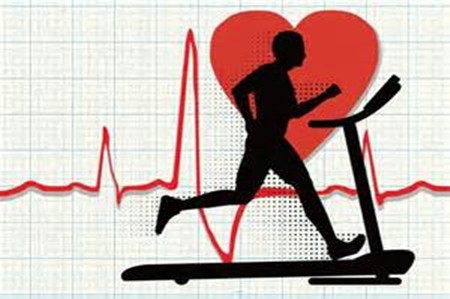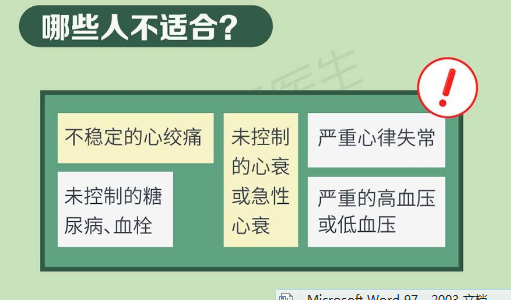A Brief Talk on Cardiac Rehabilitation
Cardiovascular disease is one of the main killers affecting the health of the people, especially the elderly. Many patients will ask: "Doctor, I have coronary heart disease, put a few stents, is it resting or exercise?" First of all, complete rest will further reduce heart function, while casual exercise increases the risk of sudden death, requiring cardiac rehabilitation under the guidance of a doctor.

What is cardiac rehabilitation?
Cardiac rehabilitation refers to the combined intervention of five core prescriptions (drug prescription, exercise prescription, nutrition prescription, psychological prescription, smoking cessation prescription) based on the overall medical evaluation, to provide comprehensive and whole-process management services and care for patients with heart disease in the acute period, recovery period, maintenance period and the whole life process.
Why do cardiac rehab?
Cardiac rehabilitation can reduce mortality not only from cardiovascular disease, but also from all diseases. The exercise-centered cardiac rehabilitation can reduce the mortality of patients with coronary heart disease by 8%-37%, the cardiogenic mortality by 7%-38%, and the sudden death by 37%. The findings suggest that walking or cycling for at least 20 minutes a day, versus less than 20 Minutes of activity reduced the risk of heart failure by 21%. Cardiac rehabilitation is an important part of maintaining physical and mental health, and for patients with heart disease, it is a key rehabilitation process. Guided by a professional medical team and carefully arranged rehabilitation program, cardiac rehabilitation can help patients manage their disease, improve their quality of life, and reduce the risk of recurrence.
How to do cardiac rehabilitation?
Cardiac rehabilitation should be carried out under the guidance and advice of a physician. In the course of implementing the rehabilitation program, the patient needs to be evaluated regularly and adjust the plan according to the recommendations of the doctor.
Cardiac Rehabilitation Remember 5 prescriptions!
Drug prescription Medication is an important part of cardiac rehabilitation. The doctor will formulate the drug treatment plan according to the specific condition of the patient, and the patient should take the drug in strict accordance with the doctor's instructions, and regularly adjust the drug.
Exercise prescription The doctor will make a risk assessment according to the patient's physical condition and type of heart disease, and formulate an individualized exercise prescription, including scientific exercise mode, exercise intensity, exercise time, weekly exercise frequency and other suggestions. The patient should follow the doctor's advice and gradually increase the exercise intensity and time.
Nutritional prescriptions also need to follow the principle of individual nutrition.
A healthy diet is essential for heart health. Patients should follow a low-fat, low-salt, high-fiber diet and limit their intake of sugar and saturated fat. Eat more vegetables, fruits, whole grains, and lean meats, while limiting your intake of processed foods and foods high in sugar.
Psychological prescription Mental health is also important for cardiac rehabilitation. Patients should learn stress coping techniques, such as relaxation training, meditation, etc., and avoid excessive anxiety and depression. Under the guidance of doctors, patients can also undergo psychological treatment.
The quality of sleep also affects the mood to a large extent, and a good grasp of sleep time and sleep regularity helps to maintain a good state of mind.
Smoking cessation prescription This is the most important part of the cardiac rehabilitation process.
If patients do not quit smoking after stenting, the effect will be greatly reduced. Because smoking increases the risk of stent clots, heart patients must quit smoking during the recovery process.
During cardiac rehabilitation, the patient should be monitored and evaluated regularly so that the doctor can understand the patient's recovery and adjust the treatment regimen as needed.

reference
1. Chinese Medical Association, Journal of Chinese Medical Association, General Medicine Branch of Chinese Medical Association, etc. Primary Guidelines for cardiac Rehabilitation of Coronary Heart Disease (2020)[J]. Chinese Journal of General Practitioners , 2021,
2, Ma Liyuan, Wang ZW, Fan Jing, et al. Summary of China Cardiovascular Health and Disease Report 2021 [J]. Chinese Journal of Interventional Cardiology, 2022(007):030.
3. Herdy A H, Ritt L E F, Stein R,et al.Cardiopulmonary Exercise Test: Background, Applicability and Interpretation[J].Arquivos Brasileiros De Cardiologia, 2016, 107 (5) : 467-481. The DOI: 10.5935 / ABC. 20160171.
Author:

Chen Gang, Master, Deputy chief Physician, Department of Rehabilitation Medicine, China-Japan Friendship Hospital. Bachelor of Medicine, Tongji Medical University, Master of Science, University of Sydney, Australia.
Member of the Promotion Committee of the combination of medical and nursing care, Chinese Geriatrics Society
He is a member of the American Society of Cardiopulmonary Rehabilitation, a member of the National Youth Committee of the Physical Medicine and Rehabilitation Branch of the Chinese Medical Association, a member of the pain Committee of the Beijing Rehabilitation Medical Association, and a corresponding editorial board of the Chinese Journal of Physical Medicine and Rehabilitation. He has been engaged in rehabilitation clinical and high-level health care work for more than 20 years. Specialty: cardio-cerebrovascular disease and orthopedic disease rehabilitation medical treatment.
(The opinions expressed are solely those of the author. Some pictures in this article are from the Internet, if there is infringement, contact delete)

